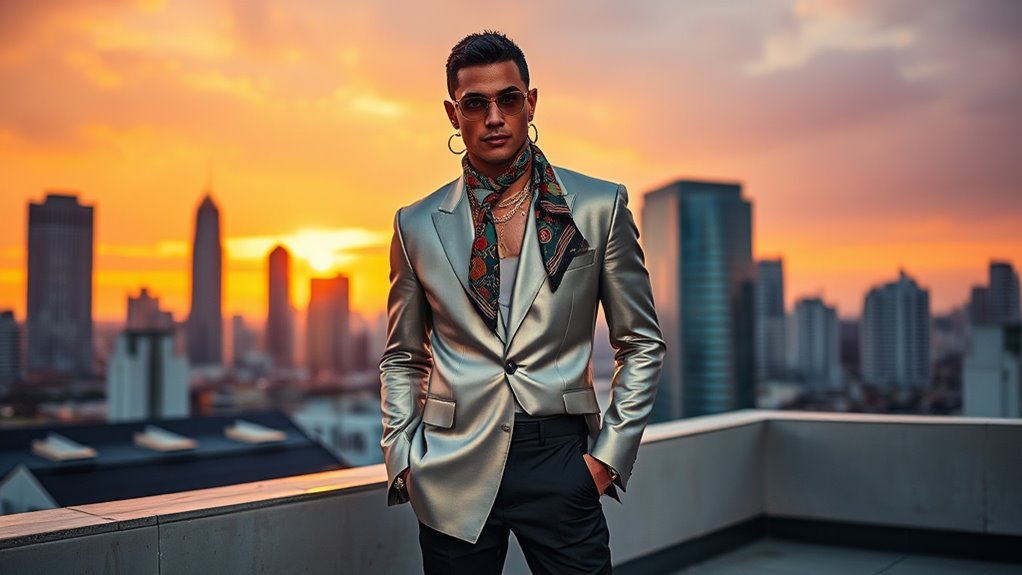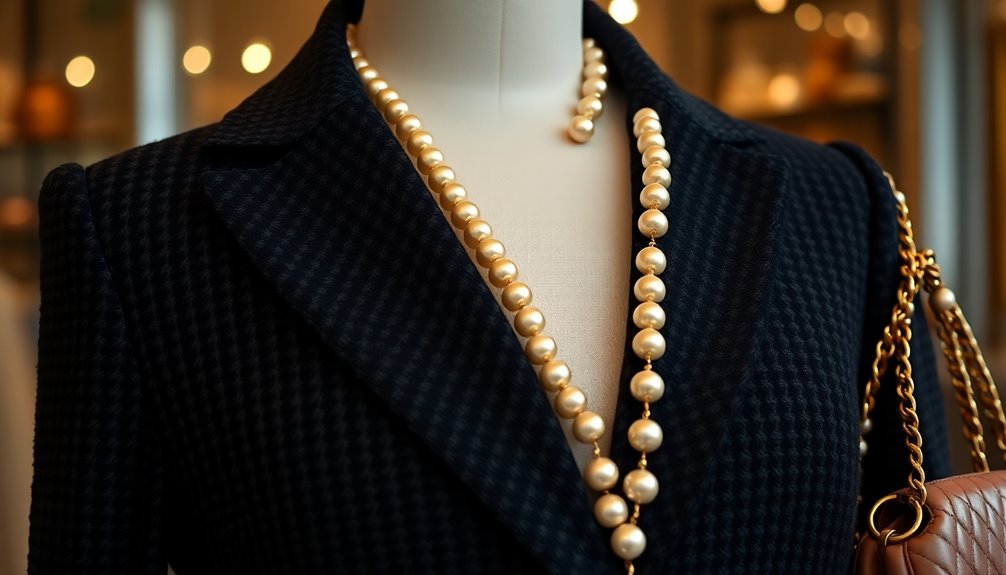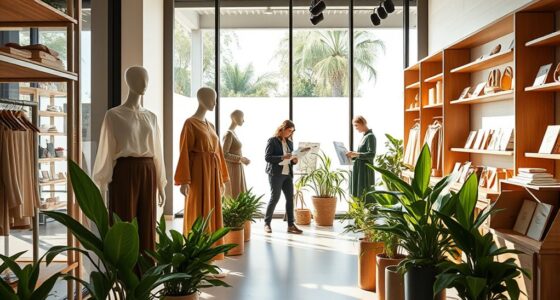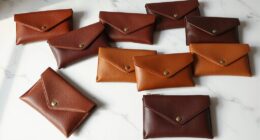Luxury fashion for men is now breaking stereotypes by embracing gender-neutral styles, sustainable materials, and global influences. Designers challenge traditional masculinity with vibrant colors, unconventional silhouettes, and inclusive collections. Influencers and icons promote expressive fashion choices, while brands prioritize ethical sourcing and eco-friendly fabrics. This evolution reflects a broader shift toward self-expression and diversity in men’s style. Keep exploring to discover how these trends are transforming the future of masculine fashion.
Key Takeaways
- Luxury brands are embracing gender-neutral collections, promoting inclusivity and challenging traditional masculine aesthetics.
- Influential icons like Harry Styles and Lil Nas X showcase diverse, non-conforming styles in high-end fashion.
- Designers incorporate fluid silhouettes, vibrant colors, and unconventional fabrics to redefine masculinity.
- High-end fashion shows feature men in skirts, dresses, and bold accessories, breaking stereotypes.
- Sustainable and ethically sourced materials in luxury menswear reflect a shift toward responsible, inclusive fashion.
The Historical Roots of Masculine Fashion Norms
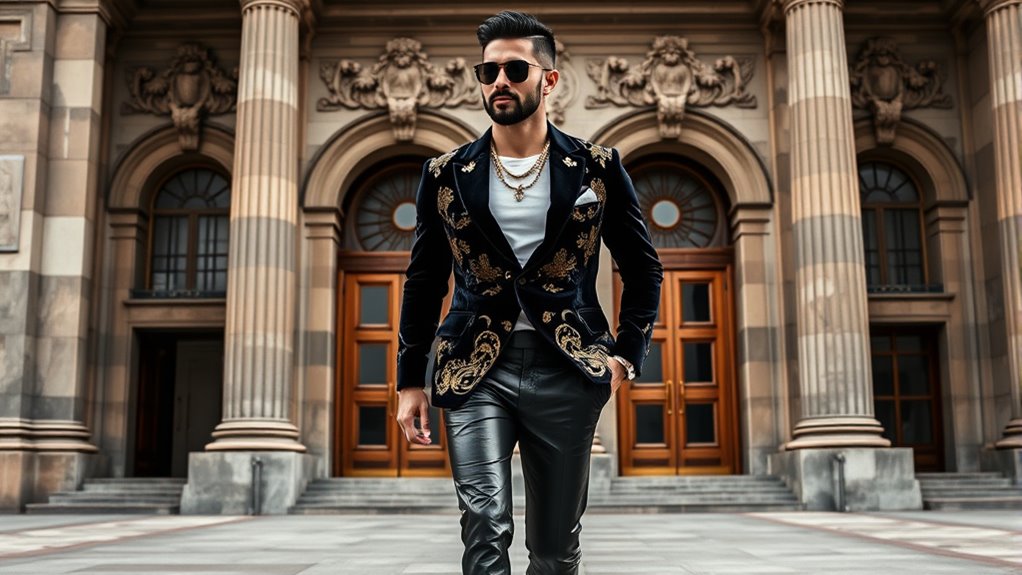
The roots of masculine fashion norms run deep, reflecting shifts in social class, politics, and cultural ideals over centuries. In Victorian Britain, societal stereotypes linked flamboyant dress to effeminacy and non-masculine traits, shaping expectations for men’s appearance. During this period, fashion-conscious figures like Oscar Wilde challenged these norms, but many still associated ornate styles with femininity. The dandy movement, led by Beau Brummell in the early 19th century, revolutionized masculine fashion by emphasizing understated elegance, perfect fit, and grooming, setting a modern template. Meanwhile, in earlier eras, men’s clothing was tied to social class—initially linked to blue-collar professions and later evolving to white-collar styles like preppy attire. These historical influences reveal how masculinity and style have long been intertwined, often constrained by societal stereotypes. Additionally, understanding the evolution of fashion trends can offer insight into how contemporary men are redefining masculinity through style. Recognizing the impact of cultural ideals on fashion choices helps explain the ongoing transformation of masculine aesthetics.
Challenging Traditional Masculinity Through Modern Designs
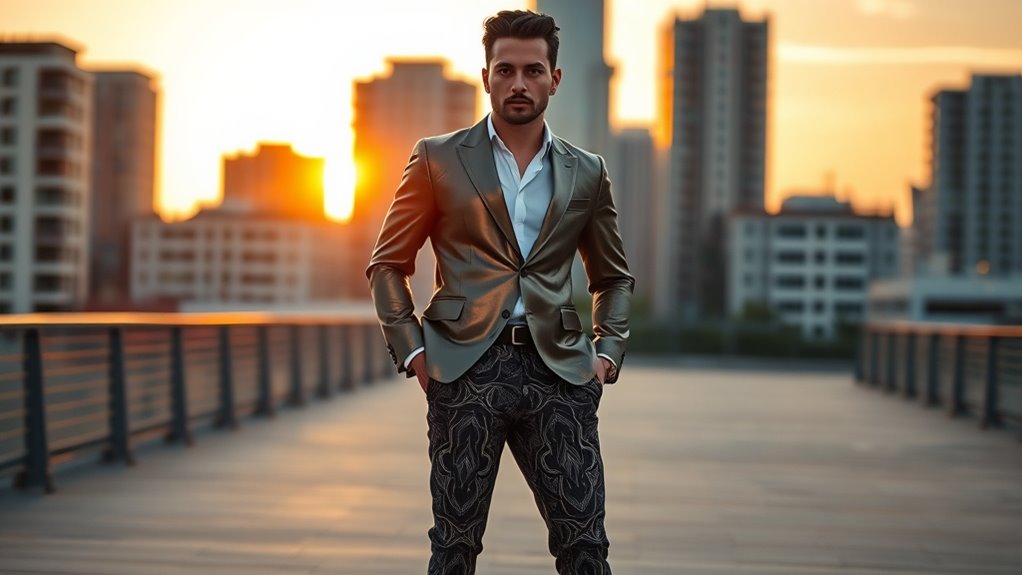
Modern designers are reshaping masculinity by embracing gender-neutral styles that break traditional boundaries. Influencers and runway shows now showcase men in vibrant colors, unconventional silhouettes, and bold accessories. These shifts encourage you to explore personal expression and redefine what masculine fashion truly means. Embracing these changes also fosters a safe space for expressing feelings, challenging stereotypes and promoting authenticity. Additionally, the rise of precious metals investments in financial planning exemplifies a broader cultural shift towards valuing diversity and individualism. Recognizing the importance of financial literacy helps individuals make informed choices aligned with their personal style and values.
Embracing Gender-Neutral Styles
As gender boundaries in fashion continue to blur, designers are actively challenging traditional notions of masculinity by introducing gender-neutral styles. You’ll notice brands like Gucci and ZARA creating versatile, gender-fluid collections that emphasize inclusivity. These collections feature unisex silhouettes, soft pastels, and sheer fabrics, breaking away from stereotypical male fashion norms. Fashion shows now showcase fluid fabrics and innovative designs that encourage men to explore diverse aesthetic expressions. The fashion industry’s shift toward non-binary color palettes and fabrics reflects a broader cultural movement toward acceptance and self-expression. As social acceptance grows, more men feel comfortable embracing gender-neutral styles, redefining what it means to be masculine in modern fashion. This evolution fosters a more inclusive environment where style knows no gender boundaries. Additionally, embracing creative practice allows designers to push boundaries and develop innovative designs that challenge traditional gender norms. Incorporating color psychology into these styles further enhances their appeal and promotes positive emotional responses. Recognizing the importance of fabric choices can help designers create clothing that is both comfortable and expressive, encouraging more men to adopt gender-neutral fashion confidently. Moreover, understanding Cultural Intelligence can assist brands in navigating diverse consumer preferences and cultural sensitivities related to gender expression.
Redefining Masculine Aesthetics
Designers like Alessandro Michele and Jonathan Anderson are actively reshaping masculinity in fashion by promoting gender-fluid collections that encourage men to explore diverse styles beyond traditional stereotypes. They challenge old fashion norms by blending elements traditionally seen as feminine with masculine aesthetics, fostering more inclusive expressions of masculinity. You’ll notice color palettes expanding to softer shades, breaking the blue and pink divide, and silhouettes emphasizing fluidity with oversized, draped garments that promote vulnerability and comfort. These evolving styles are also reflected in size limitations that guide the design and marketing of modern collections, emphasizing versatility and adaptability. Influencers like Harry Styles and Timothée Chalamet showcase these evolving styles, normalizing non-traditional, expressive aesthetics. Additionally, support hours for fashion outlets and brands often reflect these new trends by offering flexible shopping experiences that cater to diverse customer preferences. Integrating fashion inclusivity into mainstream collections further supports this movement toward broader acceptance of varied masculine expressions.
Celebrating Individual Expression
Celebrating individual expression in men’s fashion means breaking free from traditional masculinity norms and embracing styles that reflect personal identity. Modern designers are championing gender-fluid styles and unisex collections, allowing you to explore a broader spectrum of self-expression. Brands like Gucci and Loewe showcase bold colors and fluid silhouettes, challenging stereotypes about masculinity. Influencers like Harry Styles and Timothée Chalamet exemplify this shift through daring choices that celebrate diversity. Now, more than ever, fashion empowers you to explore unconventional accessories—jewelry, makeup, vibrant clothing—without societal judgment. This movement emphasizes fashion fluidity and self-awareness, fostering a culture where breaking stereotypes becomes the norm. As organizations recognize the importance of Cultural Intelligence, the fashion industry also increasingly embraces diverse expressions of masculinity, promoting greater acceptance and authenticity. Understanding the role of gender expression in shaping modern fashion helps expand the boundaries of traditional masculinity and encourages authentic self-representation.
The Role of Fashion in Redefining Male Identity
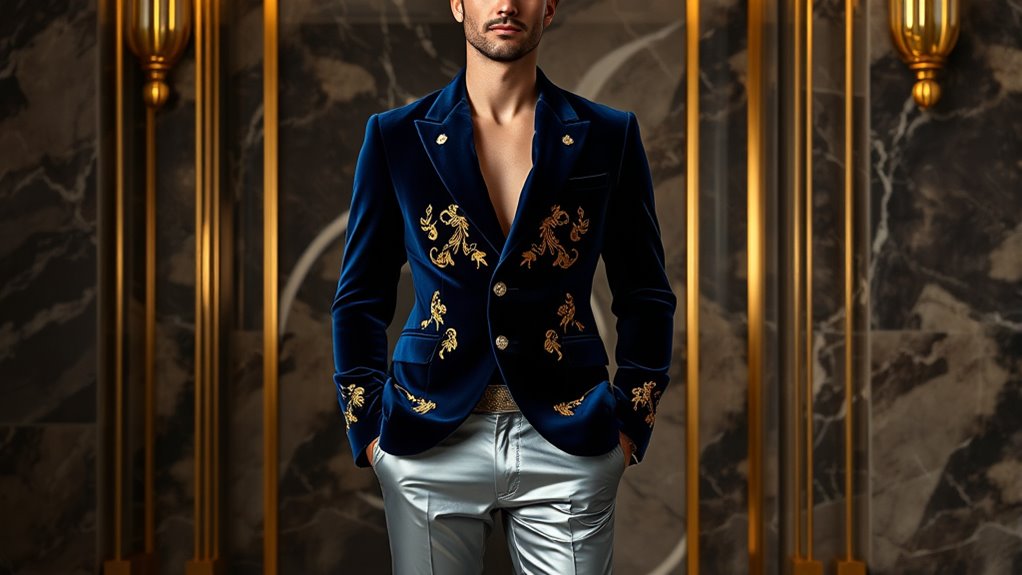
How does fashion shape modern male identity? It’s a powerful tool for redefining male roles by embracing diverse fashion choices that challenge traditional masculinity. Gender-fluid and unisex collections in luxury fashion encourage you to explore non-traditional styles, breaking stereotypes. Influencers like Harry Styles and designers such as Alessandro Michele promote gender-inclusive looks, inspiring men to express themselves freely. Historical shifts—from dandyism to streetwear—show how fashion transforms self-perception and societal expectations. Accessories like jewelry and bold footwear let you communicate your unique identity beyond conventional norms. Additionally, fashion history demonstrates how evolving trends influence societal perceptions of masculinity, enabling a broader acceptance of individuality.
Contemporary Trends That Break Gender Stereotypes
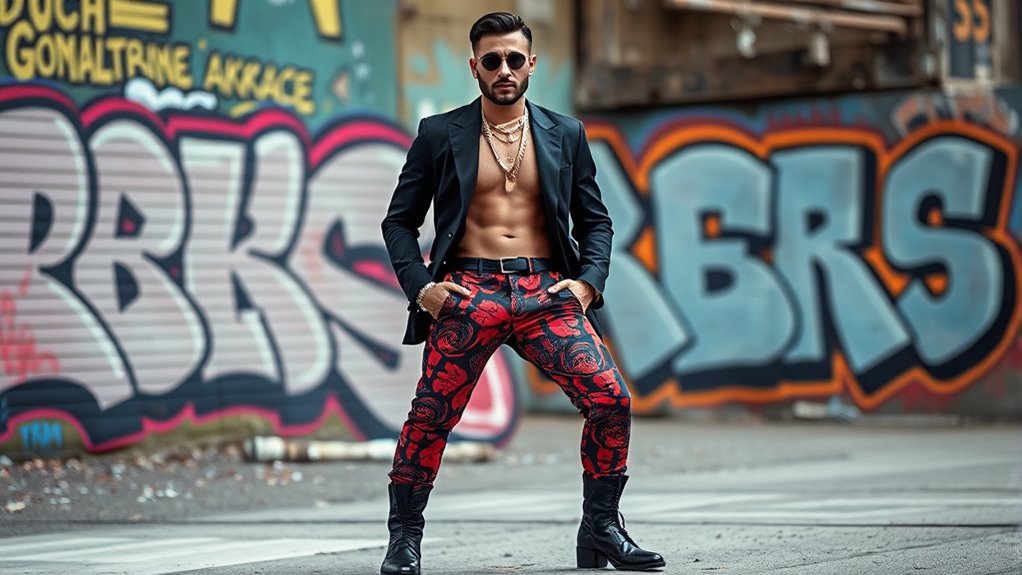
Contemporary fashion trends are actively challenging traditional gender stereotypes by embracing inclusivity and self-expression. Gender-neutral collections from designers like Alessandro Michele and Jonathan Anderson blur the lines between menswear and womenswear, promoting a more fluid approach to style. Men’s fashion now features diverse fabrics and silhouettes, emphasizing fluidity and diversity in masculine expression. A broader color palette, including pastels and vibrant hues, moves away from stereotypical blue and black tones, making bold statements. Celebrity fashion also plays a crucial role; icons like Harry Styles and Timothée Chalamet challenge masculinity norms with their daring choices. Additionally, personalized jewelry and accessories symbolize self-expression, transcending conventional stereotypes and fostering a more open, inclusive fashion landscape. Fashion innovation continues to drive this evolution, encouraging designers and consumers alike to explore new boundaries of gender expression. Furthermore, innovative fabric technologies are enabling new styles that merge comfort with avant-garde aesthetics, expanding the possibilities for gender-fluid fashion. Integrating concepts of biodiversity into fashion design, some brands are exploring sustainable materials that support environmental health and ethical practices, adding another layer of meaning to gender-inclusive apparel. The ongoing influence of cultural narratives inspires designers to incorporate diverse cultural elements, further enriching the spectrum of gender-inclusive styles.
Influential Figures Promoting Inclusive Menswear
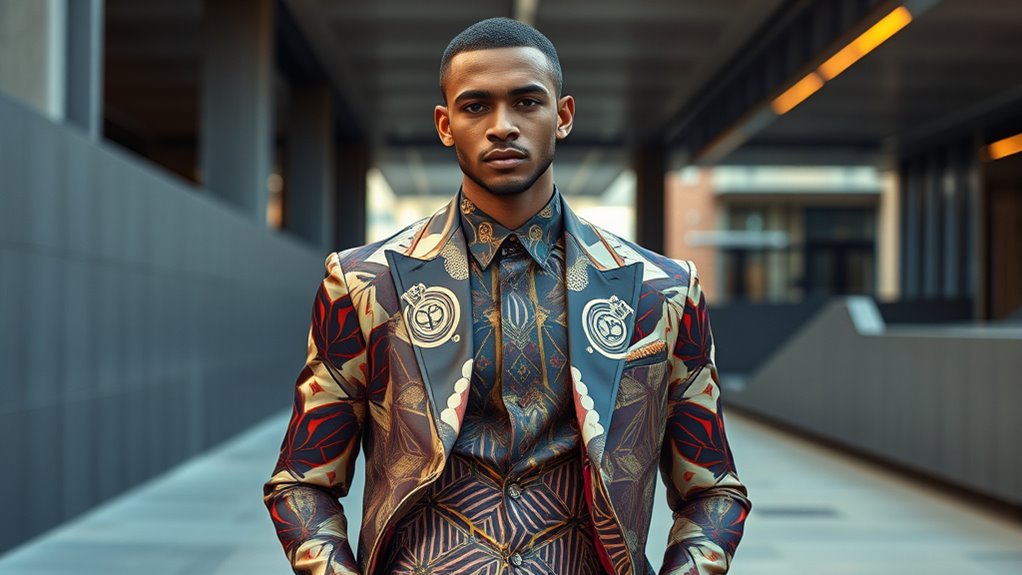
Influential figures in the fashion world are leading the charge for more inclusive menswear by embracing gender-fluid styles that challenge traditional notions of masculinity. Celebrities like Harry Styles, Timothée Chalamet, and Lil Nas X openly wear gender-neutral and androgynous outfits, inspiring fans and designers alike. Designers such as Alessandro Michele and Jonathan Anderson create collections that blur gender boundaries, emphasizing personal expression over stereotypes. Social media influencers showcase diverse, non-binary fashion choices, normalizing inclusive menswear. High-profile runway shows now feature male models in skirts and dresses, reflecting a shift toward gender inclusivity. Consumer demand grows for gender-neutral lines from brands like Zara and H&M, driven by celebrity influence and the movement toward breaking traditional masculinity norms. Fashion evolution continues to accelerate as more designers and brands recognize the importance of embracing gender diversity and individual style expression. This cultural shift is also supported by media representation, which plays a crucial role in normalizing diverse gender identities and fashion choices. Additionally, sustainable practices in fashion are increasingly integrated into collections, promoting environmentally conscious and inclusive designs that appeal to a broader audience. Moreover, the rise of inclusive marketing strategies helps brands connect with a wider, more diverse consumer base.
Sustainable and Ethical Materials as a Statement of Change
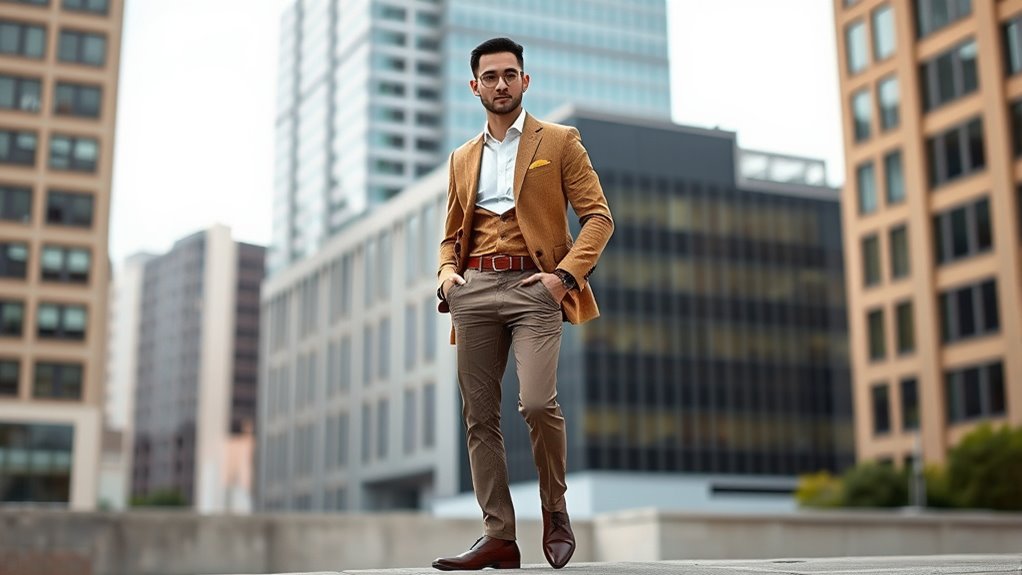
You can see luxury brands embracing eco-friendly fabrics like hemp and recycled fibers to highlight their commitment to sustainability. Ethical sourcing practices, such as transparent supply chains and fair trade, reinforce their social responsibility. By choosing these materials, you demonstrate a shift toward responsible consumption and a positive change in the industry.
Eco-Friendly Fabric Choices
Eco-friendly fabric choices are transforming men’s luxury fashion by prioritizing sustainability without sacrificing style. Hemp stands out as a premier eco-friendly fabric, requiring up to 50% less water than cotton and needing no pesticides. Advances in textile technology have made hemp softer and more luxurious, perfect for high-end fashion. Major brands like Gucci and Stella McCartney are embracing hemp for its versatility and eco benefits. Additionally, hemp is a carbon-negative crop, capturing more CO₂ during growth than processing emits. Ethical sourcing and regenerative farming practices ensure fair labor conditions and soil health, aligning luxury with responsibility. Consider these eco-friendly fabric options:
- Hemp for its sustainability and minimal water use
- Organic linen and cotton from ethical sources
- Tencel made from sustainably harvested eucalyptus
- Recycled polyester from ocean plastics
- Tencel and hemp blends for durability and eco-consciousness
Ethical Supply Chain Practices
As luxury brands prioritize sustainability, they are increasingly adopting ethical supply chain practices that highlight transparency and responsibility. You’ll see brands partnering with Fair Trade-certified producers and enforcing strict labor standards to ensure fair wages and safe conditions. Ethical sourcing of materials like organic hemp, recycled metals, and ethically sourced gemstones demonstrates their commitment to reducing environmental impact. Innovations in textile technology, such as enzymatic softening and biofabrication, allow for sustainable fabrics that challenge traditional perceptions of eco-friendly materials. Transparency initiatives, including blockchain tracking and origin disclosures, enable brands to showcase their responsible manufacturing processes. By integrating sustainable and ethically sourced materials, luxury menswear makes a bold statement of change—aligning brand values with your desire for environmental responsibility and social justice.
The Impact of Globalization on Masculine Fashion Styles
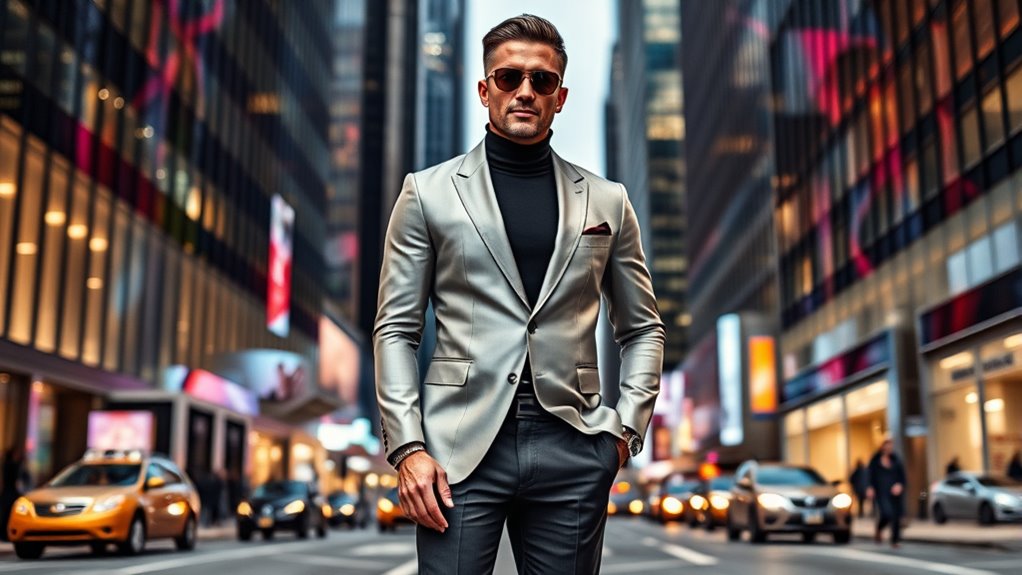
Globalization has dramatically expanded the reach of fashion, allowing men everywhere to explore and adopt a wide array of styles that go beyond traditional masculine norms. You now have access to diverse fashion styles influenced by international fashion brands and media, blending cultures and breaking stereotypes. Cross-cultural collaborations bring fresh, innovative designs that combine unconventional fabrics, colors, and accessories into masculine fashion. This global exchange encourages experimentation and challenges existing perceptions of masculinity.
Globalization expands men’s fashion through cultural blending and innovative, inclusive styles.
- Discover hybrid styles that merge Western ideals with local cultural elements
- Embrace multicultural motifs like African prints or Asian silhouettes
- Follow international fashion icons and celebrities for inspiration
- See traditional garments reimagined for modern masculinity
- Experience a more inclusive, diverse approach to men’s fashion through globalization
Future Directions in Gender-Fluid Luxury Menswear
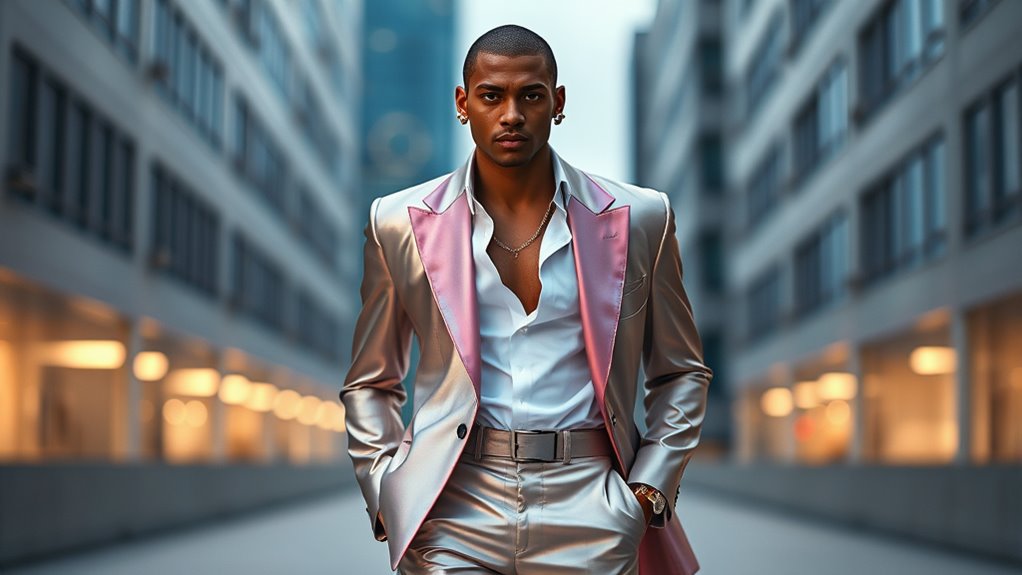
The future of gender-fluid luxury menswear is poised for significant growth as designers embrace unisex designs, fluid silhouettes, and expanded color palettes to challenge traditional notions of masculinity. You’ll see more gender-neutral fashion offerings that prioritize self-expression and inclusivity. Major houses like Gucci, Loewe, and Balenciaga lead the way with collections that celebrate diversity and break binary standards. Advances in technology, such as 3D tailoring and sustainable fabrics, make it easier to craft versatile, inclusive pieces. Cultural shifts supported by social media icons like Harry Styles and Lil Nas X help normalize gender non-conforming styles. With the global market projected to grow over 9% through 2028, gender-fluid luxury menswear is set to redefine masculinity and reshape the future of fashion.
Frequently Asked Questions
What Is Timeless Fashion for Men?
Timeless fashion for men means choosing classic pieces that never go out of style. You’ll want tailored suits, crisp dress shirts, and quality leather shoes in neutral colors like navy, gray, black, and white. Use durable fabrics like wool, cotton, and linen. These versatile, well-made items let you dress up or down easily, helping you look sharp and sophisticated, just like Cary Grant or James Bond, regardless of changing trends.
What Are Gender Stereotypes in Fashion?
Gender stereotypes in fashion are societal beliefs that link certain styles and accessories to masculinity or femininity. You might feel pressured to stick with traditional, modest clothing, avoiding bright colors or jewelry deemed feminine. These stereotypes limit your self-expression, often reinforced by media and marketing. Recognizing these biases helps you challenge norms, encouraging you to explore diverse fashion choices that truly reflect your personality, regardless of societal expectations.
Why Is Men’s Fashion Limited?
Think of men’s fashion as a garden that’s been overgrown with weeds of tradition and stereotype. These societal norms block new styles from flourishing, limiting your choices to what’s considered “appropriate.” You’re often discouraged from experimenting with colors, patterns, or accessories, because the landscape of men’s fashion has been shaped by old rules. Breaking these barriers opens up a vibrant, diverse world where you can truly express yourself without constraints.
How to Choose Fashion for Men?
When choosing fashion for yourself, focus on fit and personal style. Pick tailored pieces like blazers and trousers to look sharp, and stick to versatile colors like navy, gray, and black for easy mixing. Invest in quality fabrics such as wool and cashmere for comfort and durability. Add accessories like watches or cufflinks to show personality, and stay open to gender-neutral and sustainable options to reflect modern trends.
Conclusion
Think of luxury fashion for men as a river that once flowed strictly in one direction, shaped by old norms. Now, it’s carving new paths, twisting and turning with bold designs and inclusive ideas. As you embrace this change, you become a boat steering toward a horizon where style knows no boundaries. Keep sailing forward—your choices help transform the current into a vibrant stream of self-expression and limitless possibilities.
